IN FOCUS: Singapore’s love affair with bubble tea - an obsession that will never die?
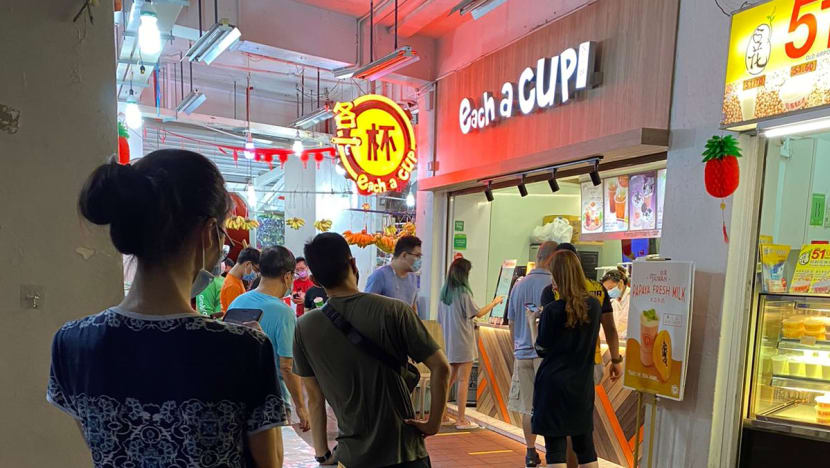
A long queue is seen at a bubble tea shop at Pasir Ris East, Apr 21, 2020.
SINGAPORE: When Singapore introduced a "circuit breaker" in April to limit the spread of COVID-19, people had questions about the implications.
What would it mean for work and family life? What about school?
For some people, one of their main concerns was about something more prosaic.
Bubble tea.
Among them was Mr Xavier Ng, who was alarmed by the news that bubble tea shops would close as part of additional restrictions on food and beverage outlets announced on Apr 21. With the measures set to kick in at midnight that evening, the clock was ticking on the last opportunity for a while to get a fix of his favourite drink.
The 25-year-old interior designer was at work and could not leave immediately. As news spread that bubble tea outlets would be closing, his friends, knowing his 10-year love for the drink, started messaging him.
When he managed to leave work at 9pm, he contacted the owner of Bober Tea, the brand he has been patronising in recent years, to make sure that the outlet in Bishan near his office would still be open when he got there.
To Mr Ng's relief, it was.
"The thought of having no bubble tea for the next one to two months made me feel like I had to go down to buy it," he said.
Mr Ng was not alone when he arrived. He had to wait for about two hours before getting his hands on a cup of brown sugar fresh milk. While he was concerned about standing in line with many other customers, he said he was comforted by the safe distancing measures in place.
"I was happy. At the very least, I could still get one cup," he said.
Such scenes were played out at many bubble tea shops across Singapore, with reports of snaking queues and long waits.
Another bubble tea lover who needs a regular fix is Ms Joyce Tan. While she was not one of those who queued when the announcement about store closures was made, both she and her husband spent half an hour on their apps trying to order the drink. They did not manage to. Demand had outstripped supply.
That does not make her any less of a bubble tea fan.
A few weeks ago, exhausted at the end of a long day, she fell asleep at 8pm, declining an offer from husband Raymond Wong to get her bubble tea. But in the wee hours, she shot awake and woke her husband up asking for the drink.
Her dutiful husband said: “Are you okay, babe? Relax, lah, your bubble tea is in the fridge.”
When she looked into the fridge the next morning, the drink was there, complete with a note from her 12-year-old son saying “For mommy”, just in case his sister thought it was for her.
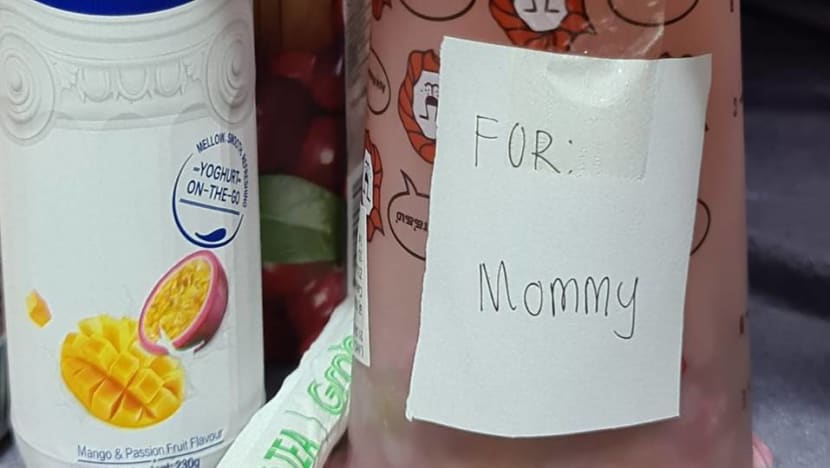
That anxious moment in the middle of the night was a first for the 48-year-old, whose love of the drink stretches back more than 20 years.
At that time, it was sold mainly at pasar malams, or night markets. She remembers fondly a robot-like doll that would bob up and down to mix the ingredients. Like today, the bubble tea stalls would draw long lines, and the wait could be long.
“It was something new, and everybody wanted to try bubble tea,” she said, speaking to CNA from her Woodlands flat.
She later become a regular at a shop called Fei Fei which employed bikini-clad models to attract the crowds.
She and Mr Wong, who is also a bubble tea fan, would stock up for the week, getting six to eight cups at once.
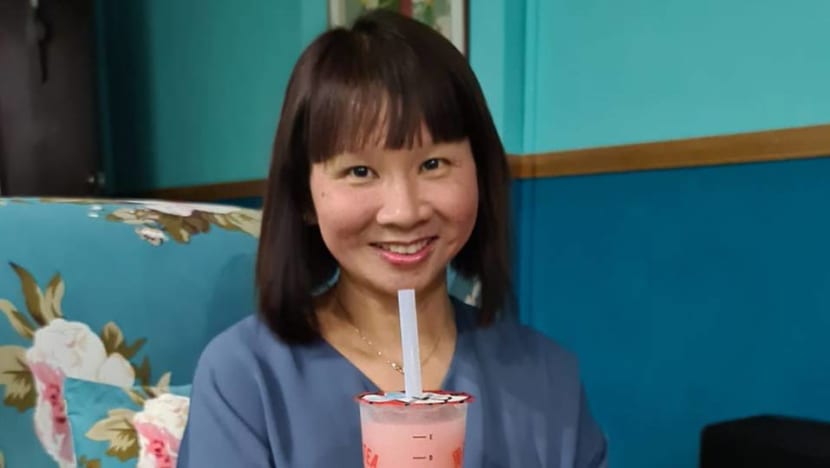
They became tired of bubble tea at some point, but with big names like Koi and Gong Cha entering the market by the late 2000s, Ms Tan and Mr Wong were again drawn to the drink.
“Personally, what I feel makes a good bubble tea, it all boils down to the pearls,” she said.
She has the drink three to four times a week now, and goes for a sugar level of 25 to 30 per cent as she is conscious of her health.
It’s my energy drink, it’s my go-to drink, especially when I have a long day at work and I just want something to perk me up, or when I have lots of work to do and I need something to keep me company while I am working.
During the circuit breaker when Ms Tan did not manage to have bubble tea, Mr Wong said she was "more spicy", referring to her quicker temper when she was not getting enough of her favourite drink.
While expounding on her love for bubble tea, Ms Tan added that it is not just bubble tea without exercise - she and her husband are avid mountain-bikers.
To this, Mr Wong chimed in: “Tell the truth, lah. We exercise because we want to drink bubble tea.”
WHY DO PEOPLE LOVE BUBBLE TEA?
These bubble tea lovers are not an exception in Singapore, where shops offering the beverage are a dime a dozen, with many major brands from Taiwan and China available here. The ubiquitousness of the outlets highlights how popular it is.
Professor Leonard Lee from the National University of Singapore Business School said that the surge in demand for bubble tea on the night before outlets had to close could be down to several reasons.
My sense is that the perception that bubble tea is a 'fun and affordable treat,' coupled with a scarcity-driven appeal and herd mentality, possibly drove much of this pre-circuit-breaker and circuit-breaker surge in demand.
However, he stopped short of calling people's love of the drink an addiction.
READ: Police investigating incident at Playmade bubble tea shop, one man arrested
“Addiction is generally associated with compulsive consumption, along with withdrawal symptoms after one abandons the focal 'substance' to which one is addicted," he said.
"But it is certainly possible that drinking bubble tea may have become a habit for some.”
Psychiatrist at Gleneagles Hospital Lim Boon Leng also said that drinking bubble tea has become a lifestyle habit for many, and that the need to change this habit during the circuit breaker period could have provoked a strong reaction from fans.
"Somehow, drinking bubble tea has certain connotations. For example, it gives a sense of ease and comfort," Dr Lim said.
He added that while making changes to one's life is difficult, it is even more challenging if it creates downsides such as inconvenience, sacrifice, or a lack of potential gain or reward.
Another factor that could have driven the circuit breaker-fuelled bubble tea mania was a fear of missing out, given the viral posts online about bubble tea stores closing.
He noted that while all other stores selling food and drinks would be covered under the circuit breaker, social media posts highlighted the looming closure of bubble tea stores. This could have led to herd mentality, as images of people queueing up to get a cup of bubble tea were everywhere at the time.
In normal times, the popularity of bubble tea could be explained in other ways beyond enjoyment of a drink, the experts said.
Drinking bubble tea may be perceived as fun, especially with the extensive variety of teas from which consumers can choose, the creative names and colourful appearance of the teas, plus the ability to customise one’s own drink or sample new “concoctions", Prof Lee said.
Some consumers may also see drinking bubble tea as a fun social activity to do with their friends, he said.
Given the wide selection of available flavours, and ingredients from which consumers could choose if they wish to “construct” their own tea, bubble tea could also allow consumers to express themselves as they get to create a beverage that matches their preference and self-identity, he said.
Another reason for the appeal is the ability for customers to decide how healthy they would like to be, he said.
"Given that one could choose more healthy ingredients as well as request a lower proportion of sugar in their drinks, consumers could perceive drinking bubble tea to be more healthy than drinking regular carbonated soft drinks," said Prof Lee, who researches consumer psychology.
Dr Emily Ortega, head of the Psychology Programme at the Singapore University of Social Sciences, said that bubble tea is "very much a social experience for many people".
A bubble tea lover herself, Dr Ortega said that eating and drinking with others allow people to bond, and this is magnified through social media.
"People don’t just share their bubble tea experiences physically, they also share their bubble tea experiences online, giving recommendations on what is good," she said.
Psychologically, some people see bubble tea as a combination between a dessert and a drink, so it feels like “more bang for your buck”, she added. There is also the "allure" of drink customisation, she said.
"Bubble tea allows people to make the drink their very own and they can change their drinks to suit their mood or to even alleviate their negative moods," she said.
She added that from a biological perspective, bubble tea is addictive because of the caffeine and the sugar.
THE EVOLUTION OF BUBBLE TEA IN SINGAPORE
While bubble tea stores today offer a dizzying variety of drinks and toppings, with customisable sugar levels, this was not always the case. Singapore’s first bubble tea store opened in Marina Square as far back as 1992, although with a completely different concept.
At the time, bubble tea was generally served in cocktail glasses and customers drank the beverage seated in shops called “bubble tea huts”.
In the beginning, bubble tea was primarily made with creamer. Fewer toppings were offered, and the flavours, made with syrup, were limited. It was also cheaper, with drinks available at under S$2.
From humble beginnings, the bandwagon gained momentum as new players entered the market to try to exploit what seemed to be an insatiable demand for bubble tea.
The industry grew and grew, until one day, it reached saturation point. The bubble tea bubble seemingly burst.
Referring to estimates reported at the time, Singapore Polytechnic School of Business lecturer Lim Xiu Ru said that there were up to 5,000 bubble tea shops here by 2002.
“The rate at which these stores were popping up within close proximity to one another, with lack of clear positioning and differentiation contributed to the eventual collapse of the bubble tea industry. The strategy which a lot of bubble tea shops took was to offer discounts (and) lucky draw promotions. These are methods to increase sales, but they do not necessarily help build brand image for the sellers,” she said.
She added that some bubble tea sellers were also focused on rapid growth and franchising, with lack of attention to staff training, focusing on quantity over quality.
As Mr Gary Lin, course chair of Temasek Polytechnic’s Diploma in Marketing, put it: “The first wave of bubble tea market was somewhat limited in variety and quality. It descended into a price war and ended in a bloodbath when the fad died.”
He noted that better-managed companies like Each-a-Cup managed to stay afloat despite having to shrink.
Speaking to CNA, Each-a-Cup founder Chua Keem Long said that the collapse of the industry, which happened around 2003, was due to a lack of training.
Then, things were done with no clear strategy, and new players were jumping onto the bandwagon without knowing how to create a cup of quality bubble tea, he said.
"When the business was good, you open, I open, everyone open, (but) the training (was) not enough,” he said.
The period of decline was the “hardest time” of his life, said Mr Chua, who founded the company here in 1999.
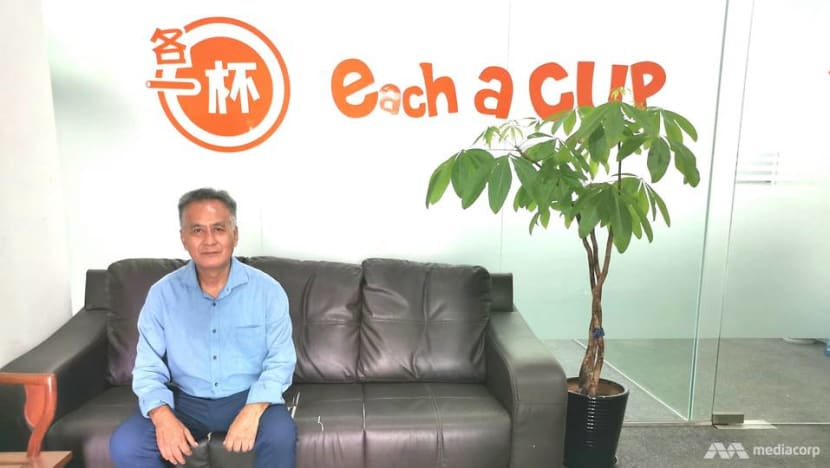
“Everyday you (have) got to struggle, make the losses. You are worried also, wondering what kind of business is this,” he recounted. Mr Chua said business shrunk from having 50 outlets to 15, and that he lost S$400,000 during that period.
He also dropped the price of a cup of bubble tea from S$3 to S$1.90. However, by the end of 2004, he broke even, he said. After that, sales picked up steadily over the years, he added.
THE BUBBLE TEA MARKET TODAY
Today, the market is more diversified, with an extensive range of price offerings, flavours and quality. For instance, the same variety of drink could be bought for anything between S$2 and S$5, depending on the outlet.
There is also more innovation as businesses look to develop new offerings to extend their appeal.
Sharetea, for instance, opened concept stores under the name Sharetea Premium which serve cold-brewed bubble tea.
“Cold brewing is a method of preparation that isn’t new to cafes but still fairly new for bubble tea brands,” a spokesperson said. She explained that in this method of preparation, tea leaves are steeped in cool water for 10 hours.
Another brand, Playmade, said that its major appeal is that it makes everything “from scratch” and offers a variety of pearls.
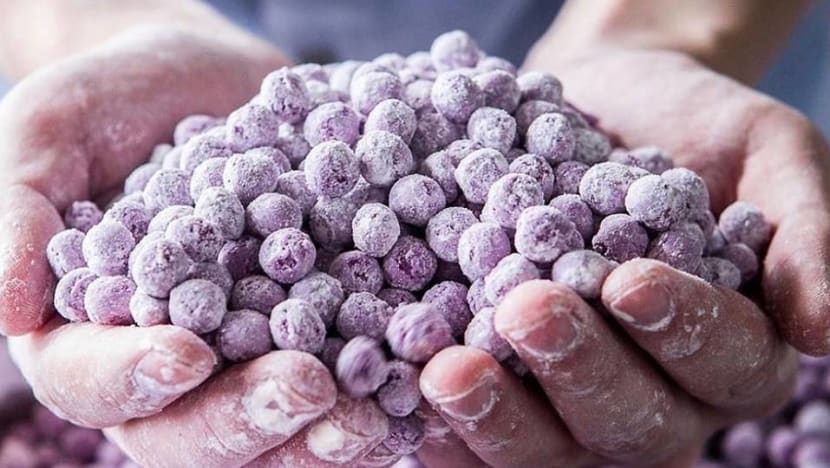
“Every cup of Playmade bubble tea is made by hand, only with the freshest ingredients. Also we make everything from scratch, like our burnt caramel, brown sugar, even our sugar solution is all made in house," a spokesperson said.
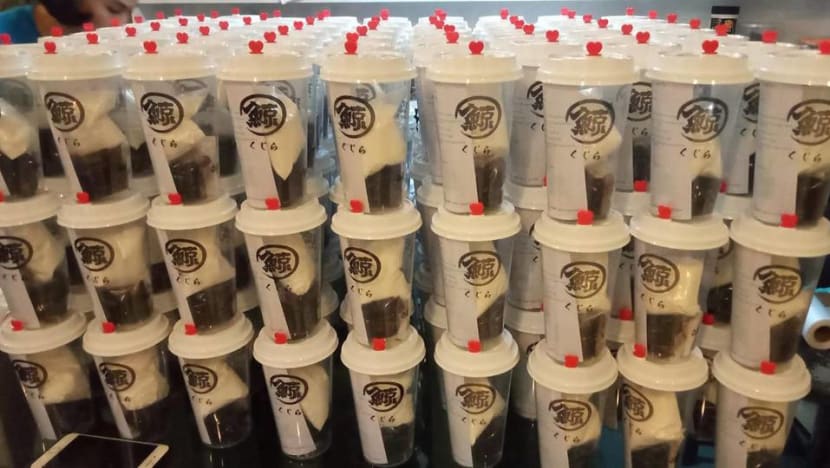
“The objective was to allow bubble tea lovers to be able to enjoy bubble tea in the comfort of their homes and bond with their loved ones while doing it,” said a spokesperson.
He added that the response was “better than we expected”, and they sold around 1,000 sets.
Each-a-Cup, on its part, sells more than 100 varieties of drink, and is constantly updating its offerings, said Mr Chua.
One drink that was removed from its menu despite it doing well was an ice-blended bandung drink.
READ: Ode to bubble tea (or why I bought a 3kg bag of tapioca pearls)
“If we want to go for ‘healthier choice’, we have to cut out a lot of things,” he said. The brand’s menu features 18 drinks approved to be healthier by the Health Promotion Board (HPB), he added.
Focusing on offering healthier alternatives may be one way for the industry to ensure its long-term future as consumer habits are constantly evolving.
THE HEALTH PERSPECTIVE
Dietician at Parkway East Hospital Jennifer Shim said that while the tea itself in these drinks is naturally low in calories and is known to be rich in polyphenols, which have anti-inflammatory and antioxidant properties, it is the other ingredients that make bubble tea less nutritious.
Ingredients such as the pearls, flavoured syrup and sugar provide a high amount of carbohydrates, she said.
“This ultimately labelled bubble tea as a sugary beverage. It adds empty calories to an individual’s diet and they provide very little nutritional value,” she said.
She added that this increases the risk of becoming overweight and obese that may lead to other diseases such as heart disease, diabetes and cancer.
She said that bubble tea drinks with toppings and at 100 per cent sweetness level consist of eight or more teaspoons of sugar. HPB's recommended daily sugar intake is eight to 11 teaspoons for adults and five teaspoons for children and teenagers.
The calories in these beverages may range from 200 to 500 per 500ml serving, depending on how they are prepared, she said.
It could take an estimated 30 minutes of high-intensity exercise such as high-knee running, mountain climbing or one hour of low-impact exercises such as swimming or walking to burn about 250 to 350 calories, Ms Shim said. The number of calories burnt depends on the duration of the exercise, the pace, intensity and a person’s weight and height, she explained.
“Even by choosing a lesser sugar option, moderation is the key. Therefore, it is still important to limit the frequency of drinking bubble tea, probably to one to two servings in a week,” she said.
Head of Nutrition & Dietetics at Mount Alvernia Hospital Sarah Sinaram said that legislation and consumer demands make it imperative for bubble tea retailers to offer healthier options.
On the part of bubble tea drinkers, she said they could opt for plain teas without milk or creamer, select 30 per cent or lower sugar levels and choose toppings which contain less than 50 calories.
READ: Sweeter than soda? The hidden sugars in bubble tea
She provided information on the calories contained in toppings. Tapioca pearls contain 156 calories, while aloe vera contains 31 calories. White pearls contain 42 calories. On the extreme end of the spectrum are foam toppings, with cheese foam containing 160 to 200 calories, and milk foam, 203 calories.
“If you do indulge in the occasional high sugar, high fat versions, do at least 30 minutes of vigorous exercise to burn off the additional calories,” she said.
TRYING TO MAKE IT WITHOUT A BIG BRAND NAME
Attempting to make it in a market that is filled with big brand names from Taiwan and China is homegrown label Bober Tea. Its founders’ decision to enter the market would most accurately be described as a whim.
Founders Joseph Oh and Gabriel Kok were in Shenzhen, China, fully committed to the idea of doing research and development for a bread and cake business. The R&D centre had been rented, suppliers sourced, industrial ovens loaded, and about S$20,000 spent.
But the two friends realised something - they were queueing up for one to two hours to buy bubble tea from popular brands Heytea and Nayuki there, and the drinks were costing them about S$10 each time. They made a quick decision to switch their focus to the beverage instead.
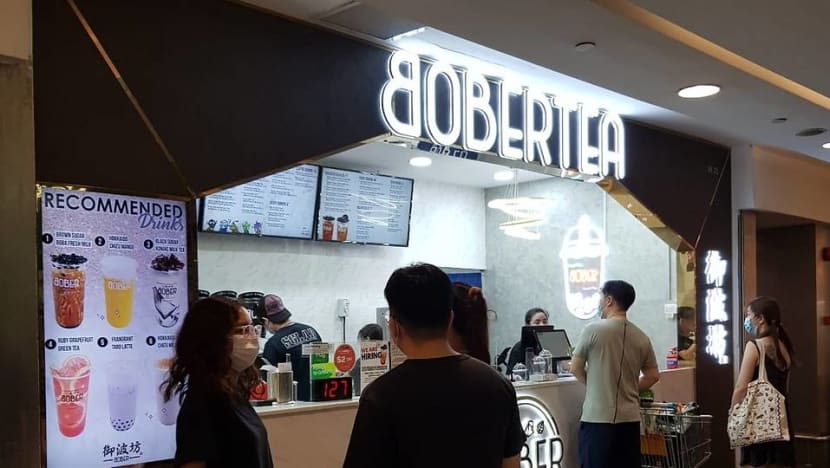
But while the business model many have chosen to take involves getting a franchising licence from big, established brands, the two men, along with co-founder Eugene Yap decided to start their own. In China, they visited a wholesale market eight to 10 times bigger than the Pasir Panjang Wholesale Centre, selecting potential tea leaves. In Taipei, Taiwan, they went to a tea fair which had close to 1,000 types of tea leaves to suss out the best and bring them home.
Mr Oh said that one reason for creating their own brand was to be able to test their drinks themselves.
“If we were to actually take a franchise business, the whole thing will be very rigid. We wouldn’t be able to change a lot of stuff to what we like and they may not know what the Singapore customers will like,” he said.
When they opened their first store in June 2018, the industry was still small, they said during an interview with CNA at their headquarters in Midview City. However, by the end of the year, the industry had ballooned, with many big names in the mix.
The founders believe they have held their own, despite the competition. Among their successes are the opening of franchises in Manila, the Philippines, and California, the United States.
However, challenges remain in a highly competitive industry, they said, and chief among them is finding the right location for new stores.
“Mall managements are skeptical, they want big brands. Even their business or sales numbers may not be good, they still want the big brands,” said Mr Oh.
In that vein, Temasek Polytechnic’s Mr Lin said that due to the market being dominated by bigger brands, the barriers of entry for small unknown brands are now higher.
BUBBLE TEA HERE TO STAY
Experts and industry players alike said that a repeat of the bubble tea crash in the early 2000s is unlikely to happen. Quoting research from Allied Market Research, Mr Lin said that the bubble tea market is projected to reach US$3.2 billion (S$4.4 billion) by 2023.
Singapore’s bubble tea industry will not see a repeat of the past for several reasons, said Mr Lin. Among them are the “great variety” that caters to different segments of the market, both in terms of price and flavours, quality of products used and the ability to choose a sugar level.
“The great variety and quality gives the consumer the power of choice, a very powerful element that helps to sustain continuous buying. It has become part of the lifestyle of many younger people (and is) not just a fad. It is now mainstream,” he said.
Ms Lim said that in the near-term, she does not think Singapore is likely to see another fall in the industry as there have been many "case studies" related to the bubble tea collapse in the early 2000s.
“These days, bubble tea operators make sure that they do ample research in terms of ascertaining market opportunity, conducting market sensing of the kind of drinks which will resonate with target customers prior to starting up business,” Ms Lim said.
She added that they make the effort to continuously focus on product innovation, testing and launching new bubble tea flavours. On top of that, bubble tea brands also pay attention to communicating the distinctiveness of their product offering and brand concept to consumers.
“We see bubble tea operators focus on marketing efforts (such as through social media) to constantly communicate with their target customers to build stronger brand image, update on new drinks and engage customers in terms of coming up with new flavours which also photograph well,” she said.
She added that bubble tea operators also pay more attention to margins and ensure that they do not undertake excessive discounting measures which eat into their profit margins and also potentially cheapen their brand image.
It is now no longer marketed as just a drink, it has become a ‘lifestyle’ concept.
Some brands let customers know of their prestigious certifications and high-quality ingredients. They focus on building strong brand positioning and R&D by trying out innovative recipes, she said.
“These are longer-term sustainable growth strategies, as compared to price cuts. These bubble tea operators also pay more attention to margins and make sure that they do not undertake excessive discounting measures which eat into their profit margins and also potentially cheapen their brand image,” she added.
The Whale Tea said that bubble tea has become ingrained in Singapore’s culture and lifestyle, unlike previously. Each-a-Cup’s Mr Chua agreed that the industry is now different.
“Today, people (bubble tea operators) who are coming in, they have experience. Those who come in without experience, they may close,” he said.
“(The industry) won’t collapse.”












